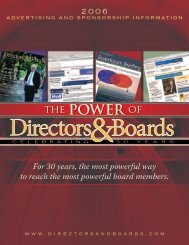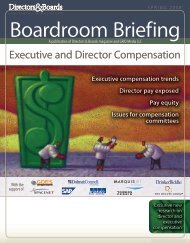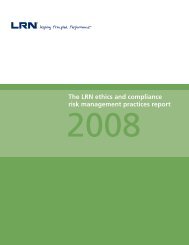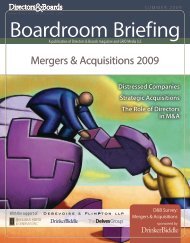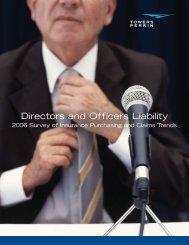Boardroom Briefing: Mergers & Acquisitions - Directors & Boards
Boardroom Briefing: Mergers & Acquisitions - Directors & Boards
Boardroom Briefing: Mergers & Acquisitions - Directors & Boards
Create successful ePaper yourself
Turn your PDF publications into a flip-book with our unique Google optimized e-Paper software.
‘Why Did You Make That Acquisition?”<br />
By James Kristie<br />
That’s one question a management team never wants to hear from its board—nor should it.<br />
The topic of<br />
the board’s<br />
role in<br />
mergers and<br />
acquisitions is<br />
quite close to my<br />
heart. For a spell<br />
during my early<br />
years as editor<br />
James Kristie of <strong>Directors</strong> &<br />
<strong>Boards</strong> I did double duty as a senior<br />
editor of <strong>Mergers</strong> & <strong>Acquisitions</strong>. Both<br />
journals came as a package in an<br />
acquisition made in 1980, so I had<br />
the opportunity to take on corporate<br />
governance as my proverbial major, with<br />
a minor in the art of M&A.<br />
The early ’80s, as it turned out, was a<br />
great time to get in on the ground floor<br />
of a merger wave that would wash over<br />
Corporate America. A tsunami of M&A<br />
deal making changed the landscape of<br />
what companies and industries looked<br />
like and even how business was done.<br />
Forget any gentlemanly arrangements<br />
for putting two organizations together.<br />
I remember the decade of the ’80s as<br />
a wild and wooly time of raiders and<br />
restructurers. It was not at all unusual<br />
to open the pages of The Wall Street<br />
Journal in the morning and have the<br />
front-page “What’s New” column<br />
be filled with offers, counteroffers,<br />
offer rejections, done deals, “floating<br />
balloons,” and hit lists of who’ll be next<br />
to wake up with a ravenous acquirer at<br />
their doorstep.<br />
I loved every minute of it, actually. It<br />
gave us a lot to write about. But it was<br />
not a lovely time in boardrooms. There<br />
was a lot of anguish generated, not just<br />
by the raiders but also by the bankers<br />
who gleefully teed up targets and<br />
by boards who, overcome by animal<br />
spirits, made moves both as hunter and<br />
hunted that were often unhinged from<br />
economic rationality.<br />
Some of the best advisories on<br />
governance we published in the pages<br />
of D&B during the ’80s were mergerrelated.<br />
When an offer, either welcome<br />
or unwelcome, hits the CEO’s doorstep,<br />
that’s when shareholders really count on<br />
the board doing the right thing.<br />
I’ve been reviewing these past M&A<br />
advisories as I develop the “Wisdom<br />
of the Ages,” the theme of <strong>Directors</strong> &<br />
<strong>Boards</strong>’ 30th anniversary issue to be<br />
published in October 2006. I’ll share<br />
Ultimate success rests with smart treatment of the<br />
talent that comes with the property.<br />
with you one of the preeminent pieces<br />
of advice I found: It’s all about people.<br />
Ultimate success rests with smart<br />
treatment of the talent that comes with<br />
the property.<br />
Here is a powerful testimonial to that<br />
principle. It’s from one of my favorite<br />
advisories, “Seasoned Advice from the<br />
Merger Arena,” published in 1985, right<br />
in the heat of the M&A land grab. The<br />
author is Sam Segnar, chairman and CEO<br />
of an energy company called InterNorth<br />
Inc. (that would later that decade morph<br />
into an outfit named Enron). He laid<br />
out a set of brilliant tactics, and the<br />
one he saved for last—“because I can’t<br />
overemphasize it”—is this:<br />
“Don’t Impose Your Standards to the<br />
Absolute. When you buy a company,<br />
you are buying a performance record.<br />
This is a company that made it the way<br />
they were structured and managed, not<br />
the way you are. You want to sustain<br />
the culture that has achieved that<br />
record. Start imposing new people,<br />
new requirements, new values, and<br />
suddenly you don’t have what you<br />
thought you bought.<br />
“When we acquired Belco Petroleum, we<br />
merged our exploration and production<br />
operations with theirs. Both were<br />
about the same size, but our cost of<br />
finding oil was twice that of Belco’s.<br />
Now which management do you run<br />
with? As basic as that sounds, it is not<br />
a common decision, and because of the<br />
interpersonal relationships involved<br />
in any merger, it can be an agonizing<br />
decision. But you want the record you<br />
bought to continue. Do anything to<br />
jeopardize that, and sooner rather than<br />
later you’ll have your board asking you,<br />
‘Why did you make that acquisition?’”<br />
M&A history is replete with case<br />
studies of company wreckage and<br />
thwarted ambitions left in the wake<br />
of a deal. This <strong>Boardroom</strong> <strong>Briefing</strong> is<br />
designed to help guide you in your<br />
M&A oversight and preempt the need<br />
for head-shaking postmortems.<br />
James Kristie is editor and associate publisher of<br />
<strong>Directors</strong> & <strong>Boards</strong>. He can be contacted at jkristie@<br />
directorsandboards.com.<br />
<br />
B o a r d r o o m B r i e f i n g : M e r g e r s & A c q u i s i t i o n s


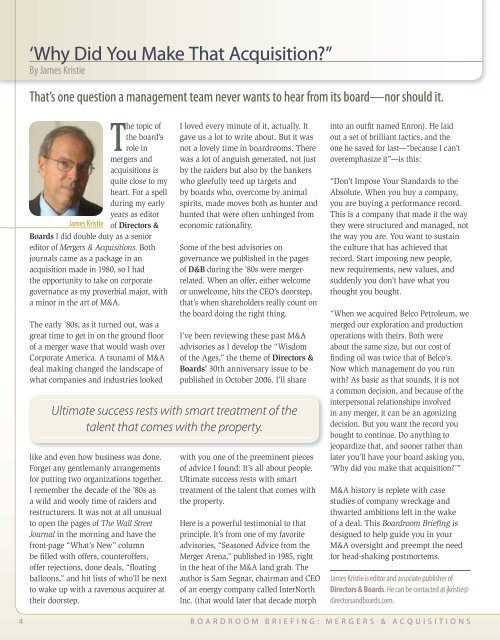
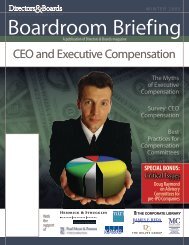

![[link to PDF] for a copy of the briefing paper - Directors & Boards](https://img.yumpu.com/43729022/1/190x245/link-to-pdf-for-a-copy-of-the-briefing-paper-directors-boards.jpg?quality=85)
